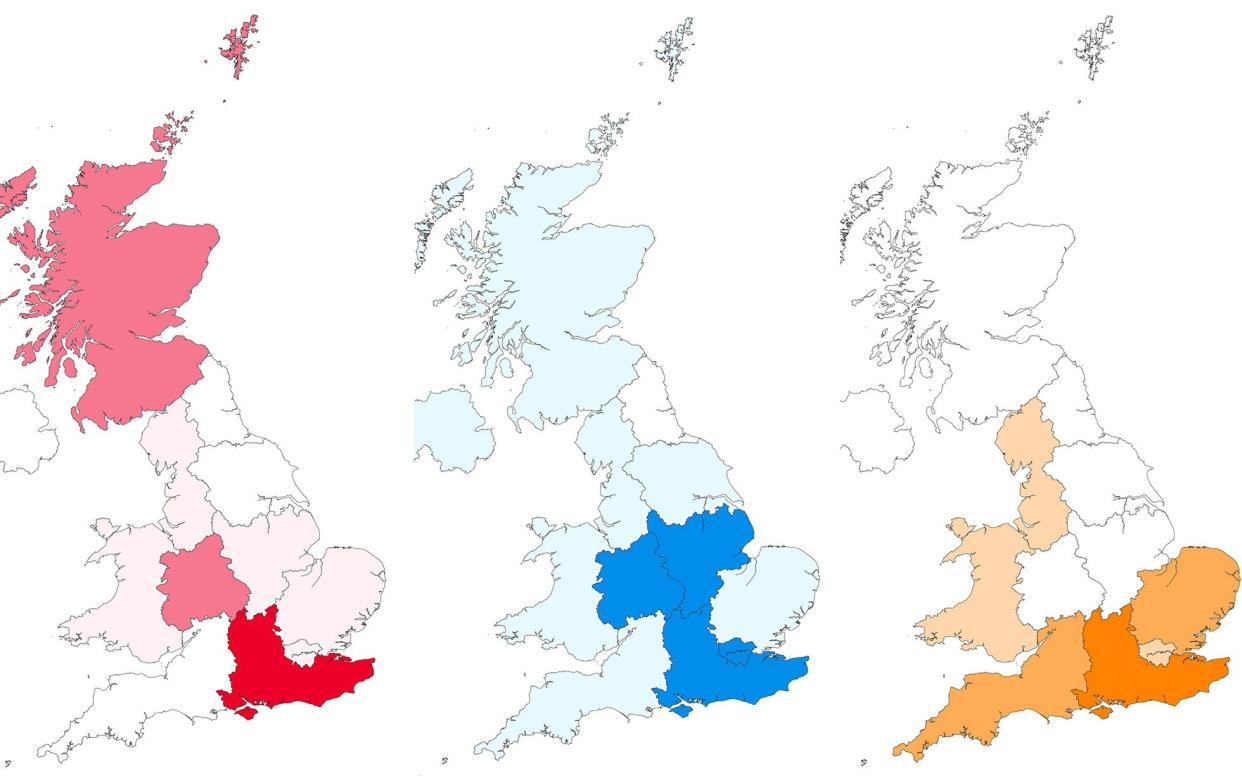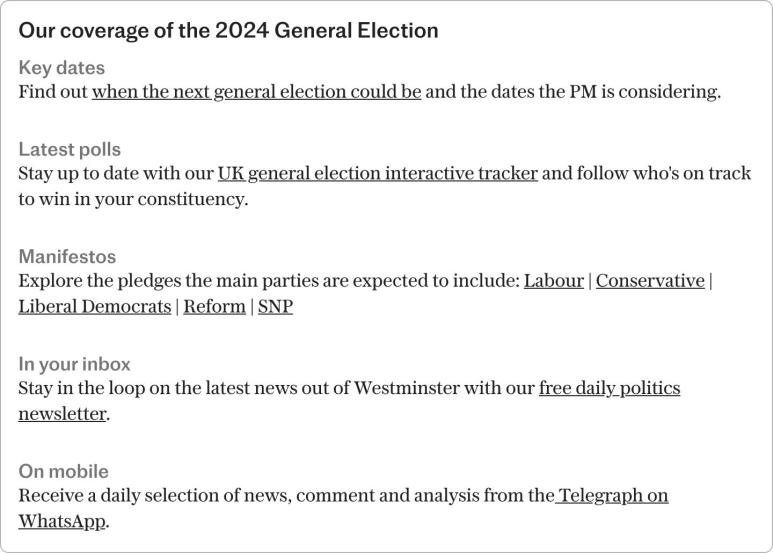Rishi Sunak visits safer seats as Tory campaign gets more defensive

With just two weeks to go until election day on July 4, Rishi Sunak appears to be doubling down on his strategy of ensuring the largest Tory majorities hold.
Having visited just one Labour seat on the trail so far, the Prime Minister’s campaign footprint suggests his focus is increasingly on staving off an insurgent Reform and the resurgent Liberal Democrats.
A heatmap of the campaign trail, which will be updated until election day, reveals that as of Friday, Rishi Sunak, Sir Keir Starmer, Sir Ed Davey, Richard Tice and Mr Farage had visited 106 constituencies between them.
Of those, 91 are seats the Tories won in 2019, nine are Labour, four are SNP, one is Liberal Democrat and one is Green. These tallies exclude public appearances for manifesto launches, TV debates and D-Day memorial services.
Conservative Campaign Headquarters’ halfway-point reboot saw a dramatic shift in the tone of its messaging. Rather than fighting for seats, the party went wholly into damage limitation. Social media quickly became awash with warnings of a Labour “super-majority”.
A vote for the Liberal Democrats or Reform would only “hand Keir Starmer a blank cheque” with no one strong enough to hold him to account. But the polls since are increasingly indicating these challengers are in for a windfall of seats.
An exclusive Savanta MRP conducted on behalf of The Telegraph revealed the Tories could be reduced to just 53 seats – the Liberal Democrats close behind with 50, and within touching distance of becoming the next opposition.
While the research didn’t show any Reform candidates prevailing, others have awarded them up to seven seats, and a handful of pollsters now show them ahead of the Conservatives in national voting intention.
What the analysis shows
The Prime Minister has held campaign events in 33 constituencies – of which 31 were Conservative home turf.
From the moment Mr Sunak called the snap poll, the strategy has been clear: shore up votes in the Tory heartlands and accept the marginals are almost assured to turn Labour.
The 2019 majorities in some of these visited constituencies are massive, and visits to places with even bigger majorities have risen as the election draws nearer.
During the opening two weeks of campaigning, the average majority in the constituency the Prime Minister was visiting was 24.5 per percentage points. Over the past two weeks, this figure has crept up to 27.5 points.
Such seats include Hinckley and Bosworth, which has a 46.5 percentage point majority, and Honiton and Sidmouth, where the Conservative candidate came out ahead by 26,229 votes. More recently, Mr Sunak appeared at an Early Years Centre in Grantham and Bourne, an area with a 45.8-point Tory majority.
He hadn’t stopped off in a single Labour seat for the past three weeks, since a June 1 visit to Blyth and Ashington. On the other hand, he has devoted resources to some of the places where Reform is currently polling highest, such as Grimsby and Cleethorpes, where the latest YouGov MRP puts Mr Farage’s party ahead of the Tories by 25 to 22 per cent.
The Prime Minister’s visit to North Devon also betrays the party’s worries that the “yellow wall” in the South West could be rebuilt. The Tory candidate won with a 26.7-point majority there in 2019, but the polls now show the Conservatives behind the Liberal Democrats by over 10 points.
Sir Keir has visited 31 constituencies, of which 25 are Conservative-held. The Labour leader has also been playing it safe from the start, favouring marginals the polls would have him win easily.
On average, the places he has visited would need just a 9.7-point swing to go Labour.
The most marginal constituency he has visited so far is Bury North, a Greater Manchester “Red Wall” Tory conquest in 2019, which Labour will be keen to reclaim. The Conservative majority there was just 105 votes – the slimmest in the country – and would require a swing of just 1.2 points to overturn.
Labour would have needed only a 1.3-point swing in Bolton North East, had not Mark Logan, the sitting MP, defected to the party in May.
Sir Keir’s most ambitious stopovers include Brighton Pavilion, which needs a 17.2-point swing from the Greens to turn Labour, and the newly created Reading West and Mid Berkshire, an area requiring a 17-point shift in its direction this time around.
The majorities in the two central London Labour seats Sir Keir has passed through – Queen’s Park and Maida Vale and Holborn and St Pancras, where he is himself on the ballot – are enormous, to the tune of 42.1 and 51.1 points, respectively.
Sir Ed Davey, the Liberal Democrat leader, has made his way across 29 constituencies, 26 of which are Tory-held and high on the Lib Dems’ target list.
His appearances have made quite the splash – engaging in a series of headline-grabbing stunts from paddleboarding on Lake Windermere to an assault course in Royal Tunbridge Wells. This unconventional strategy appears to be doing wonders for the party.
While it remains in fourth place in national voting intention, at 10 per cent and behind Reform since January, Sir Ed has been able to target ever more ambitious Tory seats – many of which in the South West the Liberal Democrats lost in the disastrous 2015 general election.
The party leader kicked off his campaign with an event in Cheltenham, the marginal constituency of Alex Chalk, Justice Secretary, which would need just a 1.3-point swing to turn yellow. Within a few days he followed this up with a visit to South Cambridgeshire, held by Anthony Browne, Tory technology minister, just a 1.2-point swing away from changing hands.
More recent stopovers include Yeovil and South Devon in the South West, both of which would require more than a 10-point swing.
Mr Farage has spent far less time on the campaign trail than his peers, instead banking on strong televised debate performances to boost his party’s popularity nationally, and repeat appearances in the Clacton seat where he is vying to become MP at the eight attempt.
Over the past three weeks he has been spotted around the constituency five times, most recently holding a rally at Princes Theatre.
Giles Watling took 71.9 per cent of the vote for the Tories in the 2019 general election. But YouGov’s latest MRP hands Mr Farage the win by a 20-point margin.
Elsewhere, Reform’s ambitions have clearly shifted towards taking on Labour. The new party leader appeared alongside Tory defector Lee Anderson in Ashfield, whom the polls now show besting the Labour candidate by a three-point margin.
Mr Farage has tried to conjure even more dramatic turns of fortune in Runcorn and Helsby and West Lancashire over the past week, where the Labour candidates are currently polling over 35 points ahead.
Age trends
It comes as no surprise that Mr Sunak is focusing on constituencies with relatively higher proportions of retirees. The Telegraph’s tracker shows over-65s to be the only demographic where the Conservatives maintain a polling lead over Labour.
Pensioners make up just over one in five voters (21.6 per cent) in seats visited by the Tory leader so far, armed with the “triple lock plus” among his policy pledges.
For Sir Keir, this average falls to 17.9 per cent, although he leads the way for the under-50s. Younger voters are considerably more likely to vote Labour. They are also the target beneficiaries of the party’s “freedom-to-buy” scheme of mortgage guarantees.
Indicative of their desire and capacity to poach votes from the Tories, the voters in areas where Mr Tice and Mr Farage have held events so far have a median age of 46.9 – higher than anyone else.
Muslim vote
The rising civilian death toll in Gaza at the hands of the Israeli military is keeping the crisis at the forefront of UK political discourse – in a country home to some four million Muslims.
As humanitarian catastrophe looms, all major parties have voiced support for a ceasefire and the return of the remaining Israeli hostages. Sir Keir’s hesitancy on the issue, however, cost him the support of many traditionally Labour-leaning Muslim communities in the local elections.
Some 5.6 per cent of voters in the constituencies the Labour leader has visited so far identify as Muslim – just below the 6 per cent national average. This ratio falls to 2.5 per cent for Mr Sunak, and just 0.6 for the Reform frontmen.


 Yahoo News
Yahoo News 
